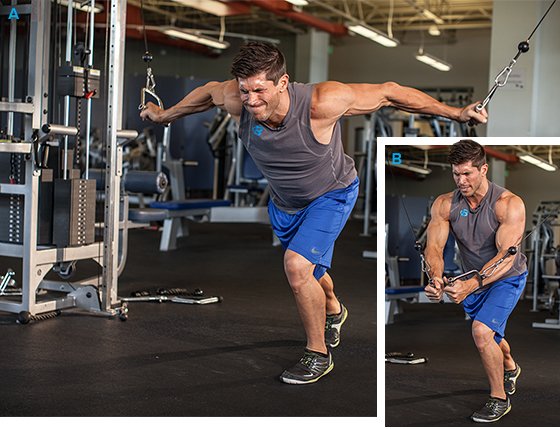Q. I keep hearing conflicting advice. Is it good or bad to train to the point of muscle failure?
There's definitely a divide in the training community on this topic. Anatomically speaking, failure occurs during the lifting phase of a repetition when the muscles can't produce sufficient force to continue to move the weight upward. But critics and supporters of training to failure often phrase their argument in non-anatomical terms, as if your stance on failure goes to the very heart of who you are as an athlete, or even a person.
On one side, you have the well-worn dictum, "Training to failure is training to fail." On the other, you've got plenty of champions who say that struggling at your limits is a critical part of muscle growth. Arnold Schwarzenegger summed up this view when he said, "The last 3 or 4 reps is what makes the muscle grow. This area of pain divides the champion from someone else who is not a champion. That's what most people lack: having the guts to go on and just say they'll go through the pain, no matter what happens."
Personally, I see evidence supporting both viewpoints. Is training to failure abused in the gym? Definitely. Does this mean it's useless? Definitely not. Let's take a look at how we can best take advantage of this divisive style of training.
The Cost of Failure
While failure may be a powerful tool in a bodybuilder's training regimen, it comes with a significant cost. For example, Spanish researcher Dr. Mikel Izquierdo found that training to failure every set drastically increased resting levels of the catabolic hormone cortisol and suppressed anabolic growth factors such as IGF-1.[1] This seems to indicate that bodybuilders who take every set to absolute failure may put themselves at risk of hindering long-term growth.
In another study at the Research and Sport Medicine Center in Pamplona, Spain, researchers found that failure training ramped up levels of the nucleotide adenosine monophosphate (AMP) quite dramatically compared to non-failure.[2] Elevated AMP is a sign that the cell is drained of energy, and when this occurs, protein synthesis decreases. The take-home message is that athletes need to be aware that this tool is taxing, and it shouldn't be treated lightly. If you're going train to failure, do so strategically and appropriately in a training program.

Training to failure is taxing, and it shouldn't be treated lightly.
Where Failure Fits
These drawbacks aside, I would say that training to failure can be anabolic in the right context. According to Brad Schoenfeld, M.Sc., CSCS, greater increases in lactic acid in muscle are critical for muscle growth, because they trigger increases in intramuscular growth factors.[3] It's also been established that training to failure increases lactic acid production more than non-failure training—although your arms could probably tell you that more convincingly than any study![5]
A second benefit to training to failure is that, near the end of a set, all of your smaller muscle fibers become fatigued. Faced with the continued challenge of lifting a heavy weight, your nervous system is forced to use your body's larger fast-twitch muscle fibers.

The only problem with this approach is that once you have taxed the nervous system on a set to failure, you develop "central fatigue." Once your nervous system is fatigued, all following sets will be performed at a much lower capacity. For example, if on one set you can get 10 reps at complete failure, you may only get 6 the second set. However, if you stopped at 9 reps on the first set, you likely would have been able to get 8 or 9 on the second set. This is because you have less central fatigue.
For this reason I recommend training to failure only on the last set of a given exercise. This is supported by research showing that failure on the last set of each exercise results in greater muscle growth and strength.[4]
Beyond Failure

Failure occurs unassisted, but there are ways, such as forced reps and dropsets, to push past even that threshold. To perform a forced rep, a trainee reaches failure and then receives assistance from a training partner to continue the set. Dropsets, on the other hand, don't necessarily require a training partner. You just continue an exercise with a lower weight after hitting failure at a higher one. In either case, your body feels these techniques even more intensely than failure, for both better and worse.
The benefits of forced reps and drop sets are similar to failure training: greater metabolic stress, more lactic acid, and more muscle fiber recruitment. However, both techniques cause far greater central fatigue than normal failure training.[5]
With this in mind, I suggest that if you choose to use these classic Joe Weider principles in your training, you do so only as a finisher on training days centered around muscle growth. When you're done, make sure you set aside time for an adequate amount of rest. This means proper nutrition and adequate sleep. Partying and drinking don't mix well with failure training.
Don't Fail at Failing
Looking for a simple, rule-based encapsulation of the above science to put in your wallet and take to the gym with you? I've got it. Training to failure is too powerful to be done incorrectly, so spread the word and help create a more anabolic world!
- Failure training can be anabolic if done sparingly, but it's catabolic if done too often.
- Failure training shouldn't be used on every set.
- If you use failure training, do so only on the last set of an exercise, and perhaps only on a hypertrophy day.
- Individuals using "beyond failure" intensity techniques should factor in additional rest when doing so. Allow your body to recover!
References
- Izquierdo M, Ibañez J, González-Badillo JJ, Hakkinen K, Ratamess NA, Kraemer WJ, French DN, Eslava J, Altadill A, Asiain X, Gorostiaga EM. Differential effects of strength training leading to failure versus not to failure on hormonal responses, strength, and muscle power gains. J Appl Physiol. 2006 May; 100(5): 1647-56.
- Gorostiaga EM, Navarro-Amezqueta I, Calbet JA, Hellsten Y, Cusso R, Guerrero M, Granados C, Gonzalez-Izal M, Ibanez J, & Izquierdo M. Energy metabolism during repeated sets of leg press exercise leading to failure or not. PloS One. 2012; 7(7): e40621.
- Schoenfeld BJ. Potential mechanisms for a role of metabolic stress in hypertrophic adaptations to resistance training. Sports Med. 2013 Mar;43(3):179-94.
- Drinkwater EJ, Lawton TW, Lindsell RP, Pyne DB, Hunt PH, McKenna MJ. Training leading to repetition failure enhances bench press strength gains in elite junior athletes. J Strength Cond Res. 2005 May; 19(2): 382-8.
- Ahtiainen JP, Pakarinen A, Kraemer WJ, Häkkinen K. Acute hormonal and neuromuscular responses and recovery to forced vs maximum repetitions multiple resistance exercises. Int J Sports Med. 2003 Aug; 24(6): 410-8.

